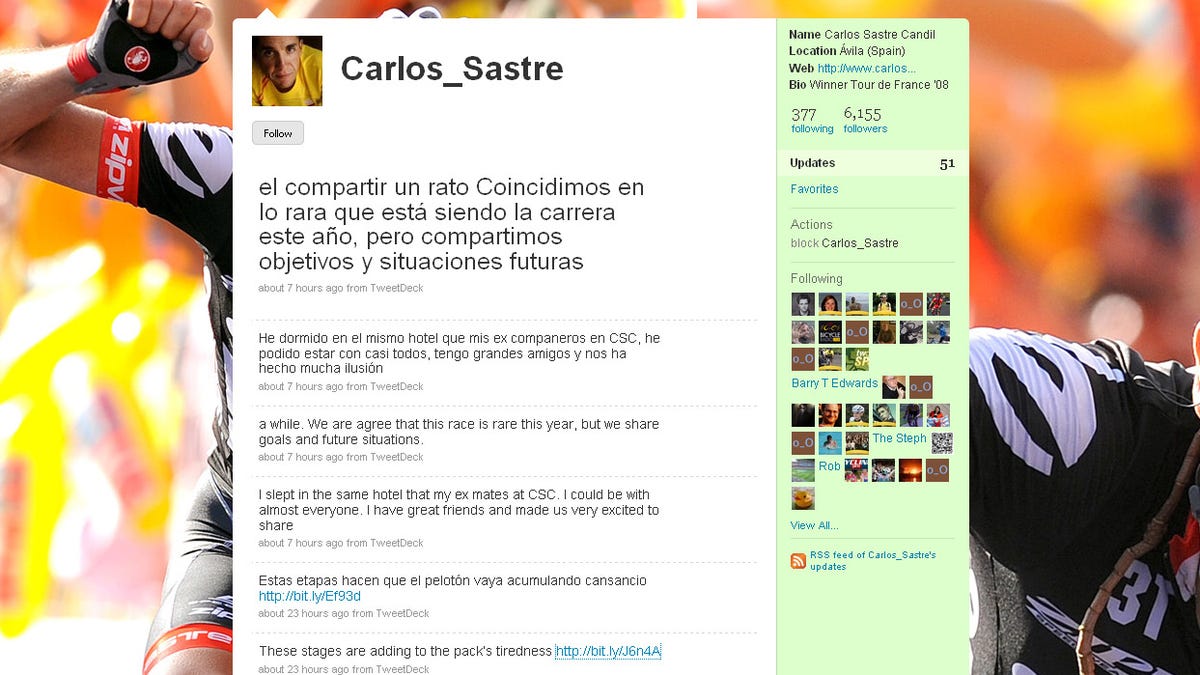Twitter takes the Tour de France on new course
Cyclists offer fans a new spin on viewing the ongoing race--through their own 140-character tweets. Find out what Lance had for breakfast...and more.

In the not-so-distant past, the only way to follow the Tour de France was through TV, newspapers, or radio. People in the U.S. (lucky enough to have cable) would wake up before dawn to watch the race in real time. Then came the Internet, which made stats and information on the race course and teams more readily available. Technology continued to expand, and last year the big advance was Google's Street View of the race.
But, now there's Twitter, which takes it to a whole other level. No longer are riders' recaps spliced into packaged sound bites, or multi-bike crashes simply breezed by and forgotten. From wind resistance to inside jokes, the kind of information fans can get has broadened as dozens of cyclists tweet their views and thoughts throughout the course of each day.
Dubbed by The New York Times as "the world's most physiologically demanding event," this year's highly anticipated Tour lasts three weeks and covers 3,500 kilometers (2,174 miles) across the flats of Marseille, winding through the Pyrenees, and finishing along the Champs-Elysees in Paris. Now, half over, the race is as exciting as ever with the return of seven-time champion Lance Armstrong, stringent doping testing, and a grand start from Monaco.
Besides the usual coverage of the highs and lows of the race, all sorts of tidbits of information are available through Twitter--what the riders ate for breakfast (Armstrong had rice and eggs one day this week), how many hours they slept (Christian Vande Velde slept 10 hours one night this week) and blow-by-blow reactions to parts of the race (Michael Rogers said the last 5 kilometers of Stage 11 was warp speed).
Collectively, the tweets provide a perspective that had been lacking in traditional sports coverage--the viewpoint of the athlete. During a crash in the tenth stage, Kurt Asle Arvesen went down hard; later that afternoon he tweeted, "The Tour is over for me :( Snapped the collarbone today."
The next morning he followed up with, "On my way home, operation tomorrow."
Simultaneously, Armstrong wrote, "Feel really sorry for him. He broke a collarbone today. Good guy!"
Not only did this information come out before the traditional news covered it, but fans could see what other riders, like Armstrong, were thinking about the crash.
Several of the tweets include back and forth banter between the racers, talking about music, meeting up, or giving each other support. Even feuds have ended on Twitter; Carlos Sastre posted that Armstrong apologized for comments he made about Sastre's win last year, and thus, Sastre wrote that Armstrong "has regained my respect."
Cyclists post personal photos of the race, like Laurens ten Dam's TwitPic of his road-rashed back after a crash. They also link to articles they've written, like Vande Velde's story in The New York Times and Armstrong's "open letter" on his Livestrong blog. This is all in addition to the insightful comments about the climbs and descents, who cyclists are starting behind, and predictions of who will win that day's stage. Even traditional news outlets are including tweets in their coverage.
Although a lot of racers are using Twitter, Armstrong is definitely the leader. With nearly one and a half million followers, he tweets several times throughout the day. As the Tour kicked off, he posted a list of all the other racers on Twitter, so fans could follow them, too. Also, his team, Astana, and team manager, Johan Bruyneel, are set up with Twitter accounts.
On the morning of Stage 13, Armstrong tweeted, "Woke up to bad news. Levi is out with a broken wrist. Damn..." His teammate, Levi Leipheimer, lost control of his bike, slid out, crashed, and broke his wrist at the end of Stage 12. Leipheimer has followed Armstrong's lead and taken to Twitter in full force. After the crash he posted, "My wrist is broken. I can't describe how disappointed I am." Then he went on to tweet during the surgery, describing the operation, posting photos and X-rays of his hand, and finally concluding with, "They 'blocked' the nerves in my arm 4 surgery. Strange experience to say the least."
Whether riders like Armstrong are using mobile phone Twitter services like TwitterBerry, UberTwitter, Tweetie, or TwitterFon, they are all getting their message out there. However, nothing is certain in these days of finicky social networkers, where 60 percent of Twitter users quit after one month. And, who knows if next year's Tour will have the same Twitter-effect. But, at least for this year, the cyclists' amalgam of tweets is definitely putting a new spin on how fans can follow the race.

